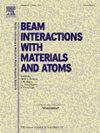辐照对FCC纳米晶金属辐射缺陷演化的影响:以Ni为例
IF 1.4
3区 物理与天体物理
Q3 INSTRUMENTS & INSTRUMENTATION
Nuclear Instruments & Methods in Physics Research Section B-beam Interactions With Materials and Atoms
Pub Date : 2025-03-14
DOI:10.1016/j.nimb.2025.165674
引用次数: 0
摘要
材料的辐射损伤伴随着缺陷的产生。描述缺陷演化的一个有希望的方法是使用化学速率理论。本文旨在研究辐照和外界条件对纳米晶fcc金属辐射点缺陷演化的影响。我们使用了纳米晶镍,我们知道它的参数,作为一种模型fcc金属。这种方法也可以应用于纳米颗粒。通过求解非平稳方程,建立了缺陷浓度与辐照时间、剂量、温度和纳米颗粒尺寸的可能关系。发现缺陷浓度随晶粒(或颗粒)尺寸的增加而增加,不依赖于尺寸,非单调且最大,或与尺寸成反比而减少。这种可变性是由外部边界缺陷相互作用的强度、颗粒(粒子)内部的重组、温度、时间(剂量)和辐照制度保证的。本文章由计算机程序翻译,如有差异,请以英文原文为准。
Influence of irradiation on the evolution of radiation defects in nanocrystalline FCC metals: The case of Ni
Radiation damage in materials is accompanied by generation of defects. One promising approach for describing the evolution of defects involves using chemical rate theory. We aim to study the influence of irradiation and external conditions on the evolution of radiation point defects in nanocrystalline fcc metals. We used nanocrystalline nickel for which we know the parameters as a model fcc metal. The approach can be applied to nanoparticles as well. By solving the non-stationary equations, possible dependencies of defect concentrations on irradiation time, dose, temperature and nanoparticle size have been established. It was found that there are situations where the defect concentration increases with increasing grain (or particle) size, does not depend on size, is nonmonotonic with maximum, or decreases with an inverse dependence on size. This variability is ensured by the intensity of defect interactions at external boundaries, recombinations inside the grain (particle), temperature, time (dose), and irradiation regimes.
求助全文
通过发布文献求助,成功后即可免费获取论文全文。
去求助
来源期刊
CiteScore
2.80
自引率
7.70%
发文量
231
审稿时长
1.9 months
期刊介绍:
Section B of Nuclear Instruments and Methods in Physics Research covers all aspects of the interaction of energetic beams with atoms, molecules and aggregate forms of matter. This includes ion beam analysis and ion beam modification of materials as well as basic data of importance for these studies. Topics of general interest include: atomic collisions in solids, particle channelling, all aspects of collision cascades, the modification of materials by energetic beams, ion implantation, irradiation - induced changes in materials, the physics and chemistry of beam interactions and the analysis of materials by all forms of energetic radiation. Modification by ion, laser and electron beams for the study of electronic materials, metals, ceramics, insulators, polymers and other important and new materials systems are included. Related studies, such as the application of ion beam analysis to biological, archaeological and geological samples as well as applications to solve problems in planetary science are also welcome. Energetic beams of interest include atomic and molecular ions, neutrons, positrons and muons, plasmas directed at surfaces, electron and photon beams, including laser treated surfaces and studies of solids by photon radiation from rotating anodes, synchrotrons, etc. In addition, the interaction between various forms of radiation and radiation-induced deposition processes are relevant.

 求助内容:
求助内容: 应助结果提醒方式:
应助结果提醒方式:


